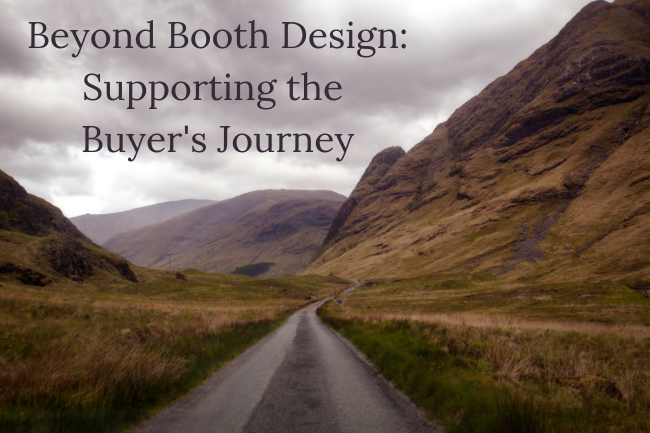Beyond Booth Design: Supporting The Buyer’s Journey

Every company who exhibits at a trade show knows that your booth design needs to be on point. It’s the thing that’s going to capture your audience’s attention, making an impression on them literally in seconds. Booth design is more than just the build and the messaging around products and services. It’s about the buyer’s journey and how the exhibitor connects with the prospect to best meet their needs.
What is the buyer’s journey?
The buyer’s journey is the process that buyers go through to become aware of, consider and evaluate, and decide to purchase a new product or service. Though these buyer’s journeys may vary company to company, there are three stages that every customer goes through before they buy a product or service.
- The Awareness Stage: this is where the buyer realizes that they have a “problem” or need that they need a solution for.
- The Consideration Stage: this is where the buyer further defines the “problem” or need and researches options to solve it.
- The Decision Stage: this is where the buyer makes their decision on a solution.
When exhibitors think about booth design, they should consider how their booth addresses visitors who may be at these varying places in the buyer’s journey. In general, trade shows are a great way for exhibitors to showcase their products and services and create awareness for them, as well as to help buyers potentially identify that they have a problem or need that can be solved by the exhibitors offerings. Let’s look at some things exhibitors can do in each stage to take the buyer’s journey into consideration.
Awareness Stage
Once in the booth, there should be ample space to mingle and chat with the booth team about their products and services. They shouldn’t feel cramped or overwhelmed by a bunch of stuff going on in the booth. Perhaps there’s a space that allows for some conversation, near a kiosk, table, something similar. The booth team should be prepared to ask some open ended questions to learn more about what the visitor knows about their company, as well as to rely on technology to help visitors learn more if all booth staff are busy.
Help attendees learn more on their own with short “about us” videos playing and/or QR codes to scan that can have them download PDF’s and brochures to review at their leisure, which sometimes can be more beneficial than during the rush of the show, and also increases the chance of review vs. paper brochures, etc. that tend to get lost in the shuffle.
Consideration Stage
Some booth visitors may already know about a company’s products or services, and are interested in learning more and/or comparing to what other companies have to offer. This is such an incredible opportunity for exhibitors to capture leads at this stage with things like live demos of products, content that can be downloaded such as case studies, success stories, etc, that help potential customers see the value of their products and services and how they’ve helped other companies like theirs.
Booth staff again should have space to have these conversations and/or a way to capture the visitor’s interest and even set up time to meet during the show to discuss further, if they’re ready. In addition, having scheduled times for demos during the show, and/or even having existing customers speak to the solutions can be a game changer for engaging visitors. Putting these things up on social media for the show as reminders, as well as sending reminder emails to visitors whose emails have been captured can help keep them coming back for more and staying engaged.
Decision Stage
The best case scenario for the decision stage and being ready for a lead or prospect that’s in this stage, is to already know that ahead of time and to set up a meeting at the show with the prospect to forward the decision making process.
Many times, these meetings are super successful because of the buzz of the show, the work an exhibitor has done ahead of time, and the booth experience helping to seal the deal. Sales staff should be on their game to treat these prospects almost like VIP visitors and engage them in any additional events they’re hosting, etc.
The other ideal scenario, should an exhibitor’s buyer’s journey allow for it (i.e a sales cycle that’s “short” vs. long) is that a visitor comes in and essentially gets walked through the stages of the journey in the booth. They come in, they are engaged with booth staff, they learn about their product, identify how it can help their business, gain more valuable insight with demos or other means, and then they’re ready to buy!
There should be a way for them to do so. Whether it’s on hand product and/or having the quote/order processing tool accessible at the show – readiness is key! Being prepared for the best case scenario = the best case scenario being possible!
Booth design that takes the buyer’s journey into consideration creates better results
Exhibitors that are clear about their prospects buyer’s journey and are prepared to meet them in the booth at each different stage, will create much more successful sales outcomes than those that aren’t. And, they’ll also help to produce more qualified and engaged leads to continue to follow up with beyond the show, which is a win for both the exhibitor and the prospect.
Superior Expo Services is a leading family owned trade show general services contractor with over 25 successful years in the business. We know what it takes to ensure that you, your show, and your exhibitors are supported and set up for success. We pride ourselves on providing superior performance that rivals the big guys, yet never compromises our grassroots customer-centric approach to project management, personal service and attention to every detail.
